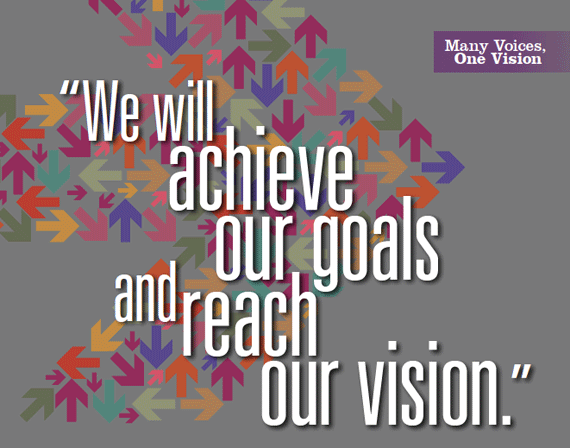
The closing sentence of the executive summary of IIT’s new strategic plan, Many Voices, One Vision(MVOV), is short on words but long on determination. While planning documents serve to outline the goals, aspirations, and projections for an institution’s success, the most powerful words are those that say, unequivocally, that the success will be achieved. The “will” gives rise to a way.
“MVOV is a detailed plan with ambitious objectives, but its success is well within our reach if we remain positive,” says IIT President John Anderson. “The tone of the plan—as much as the tenets of the plan—sends a strong message to the IIT community that we are committed to achieving excellence.”
The planning process began in February 2008 with the convening of a working session of the Executive Committee of the Board of Trustees. This led to the assembly of the MVOV steering committee—consisting of students, faculty, staff, and alumni—headed by Vice President for Business and Administration John Collins, and Associate Professor of Physics and Chair of the Faculty Council Christopher White. The steering committee held informational sessions about MVOV, which outlined the plan’s goals and objectives, and in summer 2008 invited members of the IIT community to contribute ideas about what they believe the university’s strengths and future priorities should be. During summer 2008, the committee reviewed more than 300 suggestions from 660 people who registered online to be a part of the process.
The steering committee consolidated these ideas into a concise report. Meanwhile, the university’s academic deans and a group of student leaders each also authored reports on the critical issues facing IIT. The three reports were shared with IIT senior administrators and trustees, and have helped to shape the plan, which was approved May 28, 2009, by the Board of Trustees.
“We were convinced that the strategic plan would only succeed if we engaged and embraced all of the constituencies within the broader university community and opened ourselves up to unconventional thinking,” says White. “The process used by the steering committee was difficult, yet the struggles proved fruitful in the end. We were eventually able to avoid a traditional planning process and draft a truly innovative report.”
“I am impressed by how so many members of the IIT community were engaged in helping to identify these priorities. Their level of input was unprecedented,” says David Baker, vice president for external affairs and director of the Office of Institutional Strategy, which was established in January 2008 to lead the MVOV effort.
The university priorities developed through the plan emphasize distinctive, value-added educational programs, interdisciplinary research based on university-wide themes, initiatives that inspire innovation and excellence among faculty and staff, and investment in engineering and science. Underlying the other priorities is a commitment and plan to assure long-term financial strength. All the priorities are intended to position IIT to attain its ultimate goal: to be an internationally recognized university.
Woven throughout the MVOV report, and reflected in the priorities, are several values and core principles intended to guide the IIT community as it works to implement the plan. Driving toward a culture that embraces change, these values and principles include focusing on students, strengthening the faculty and staff, engaging alumni, and making a commitment to a diverse and inclusive community of scholars and innovators.
The plan offers some time-proven objectives and action steps aimed at improving upon ongoing efforts. There is a continued focus on Chicago as a partner in education and research, interdisciplinary coursework and research, and steps toward greater financial solvency and flexibility.
But MVOV also offers a unique set of constructs that are intended to help distinguish IIT from other institutions of higher education.
To begin, IIT is aiming internationally. While this encompasses both the vision and the core principle of heightening visibility, it also addresses more specifically proposed new initiatives such as the International Academy. In addition, efforts to further enhance interdisciplinary research, particularly of topics of global significance, and the priority of elevating the engineering discipline, are expected to boost the university’s relevancy in the global arena. Two interdisciplinary research themes—Energy and Sustainability, and Improving the Quality of Life—have been selected, and at least two other priority themes will be determined in the coming months.
Another new concept, the Innovation Sandbox, is outlined in the vision and priorities, and rooted in the university’s Bauhaus legacy, which places a premium on innovation, creativity, and new technology. To be developed over time, the Innovation Sandbox will serve as a virtual studio intended to generate and promote new ideas. An incentives program will encourage students and faculty to develop creative initiatives that will benefit society and the university.
Similarly, the strategic priority of promoting innovation and excellence throughout the university taps IIT’s “many voices” as a resource. MVOV calls for increased university-wide participation of all members of the IIT community in order to usher the plan’s success. This includes improving faculty and staff retention, customer service, and campus operations, and introducing new survey tools and efforts to reward quality work.
Also new is the context in which education is defined. More than just bettering academic programs and recruiting talented students, MVOV aims to prepare students for change—producing graduates who are open and creative thinkers with relevant skills developed through enhanced IIT Leadership Academy and Interprofessional Projects (IPRO) courses, and development of the new International Academy.
“We want to provide our students every tool possible to be experts in their chosen discipline and to have the confidence to advance society,” says Provost and Senior Vice President for Academic Affairs Alan Cramb. “That means offering students challenging and relevant courses and research projects that stimulate creativity. We will teach our graduates how to think in many ways—as an engineer, a scientist, a lawyer, a designer, an architect, a psychologist, and as a business person—all of which will help them see the world from multiple perspectives and prepare them for a life of reaction to change.”
In shaping the university’s new priorities over the past 16 months, “we looked to our core strengths while also redefining the university of the future,” says Anderson. His paper on this two-tiered approach, “Innovation in a Technology-Oriented University: IIT as an Innovative Studio,” was posted on the MVOV website for discussion during the planning stage. “We need to focus on the areas where we can make the biggest impact, but we also must wholly encourage freedom of thought and innovation if we are to make lasting improvements.”
Stay informed of IIT's development and implementation of theMany Voices, One Visionstrategic plan in upcoming issues of IIT Magazine and on the MVOV website, http://manyvoices.iit.edu. Online, you can also read posts to the MVOV Reading Room, which include thought-provoking articles and discussion about strategic planning, a subscription list for updates on MVOV progress, and a forum where the IIT community can discuss the plans.
The last major strategic plan to be implemented at IIT was the Report of the National Commission for IIT, released in 1994. The report, written by IIT trustees, outside experts, and faculty and administrative leaders, was published during a particularly difficult time in the university’s financial history.
“During the National Commission, IIT was in grave condition,” says Baker, who served as executive director of the commission. The group’s recommendations emphasized making enrollment more competitive and selective, and addressing IIT’s location and fiscal concerns. This led to the Camras Scholars program, the IPRO program, and a capital campaign that also helped to finance new buildings and facilities improvements.
“IIT is in a different place now, thanks to the outcomes of the National Commission,” says Baker. “Because of it, IIT has grown stronger in the past decade and is in a position where its can prioritize innovation and taking the university to the next level. Creative ideas such as the Innovation Sandbox would not have been feasible in 1994.”
With MVOV slated for deployment through 2014, ultimate measurement of its success is five years away. Only then will its metrics—which outline everything from minority faculty recruitment and research expenditures to retention and successful customer transactions—reveal its outcomes.
“I am confident that we have developed a plan that is attainable and that reflects the goals and aspirations of the IIT community at large,” Anderson says. “Our university has all the potential to be a leader in developing ideas and graduates that will have an impact on the professions and future technology.”

MANY VOICES, ONE VISION
JOINING PRIORITIES WITH VALUES AND CORE PRINCIPLES
IIT Priorities
- Distinctively define the IIT graduate
- Increase the impact of IIT’s research by
focusing on interdisciplinary themes - Promote innovation and excellence
throughout the university - Elevate engineering’s reputation to
international stature
IIT Values and Core Principles
- Focus on students
- Strengthen faculty and staff
- Foster leadership and ethical decision-making
- Commit to diversity and excellence
- Focus on resource management
- Heighten reputation
- Engage alumni
Mission and Vision
IIT's new vision and mission were developed during the Many Voices, One Vision strategic planning process.
Vision
IIT will be internationally recognized in distinctive areas of education and research, using as its platform the global city of Chicago, driven by a professional and technology-oriented focus, and based on a culture of innovation and excellence.
Mission
To provide distinctive and relevant education in an environment of scientific, technological, and professional knowledge creation and innovation.
More Online
Many Voices, One Vision website: http://manyvoices.iit.edu
The “Blue Ocean” approach to creating unique markets, in Harvard Business Review: www.courtenayhr.com/images/Blue%20Ocean%20Strategy.pdf
“Innovation in a Technology-Oriented University: IIT as an Innovative Studio”: web.iit.edu/strategic-plan